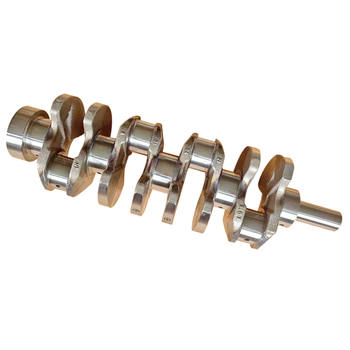Introduction
When it comes to engine performance, there are few components as critical as the crankshaft. The crankshaft is responsible for converting the linear motion of the pistons into rotational motion that drives the vehicle. However, the design and engineering of crankshafts is a complex science that requires a deep understanding of mechanical engineering principles.
The Basics of Crankshaft Design
The crankshaft is typically made of steel or cast iron and consists of a series of journals and cranks. The journals are the bearing surfaces that support the crankshaft, while the cranks are the arms that connect the journals to the pistons. The crankshaft design must be carefully balanced to ensure that it rotates smoothly and evenly. This is accomplished through a process called counterbalancing, which involves adding weights to the crankshaft to offset the weight of the pistons and rods.
Crankshaft Materials
The choice of crankshaft material is critical to its performance. Steel crankshafts are the most common and offer excellent strength and durability. However, they are also heavier than other materials, which can impact engine performance. Cast iron crankshafts are less common, but are often used in heavy-duty applications due to their ability to handle high loads. Other materials, such as aluminum and titanium, are also used in some applications, but are typically more expensive and less durable than steel.
Advanced Crankshaft Designs
While the basic design of the crankshaft has remained relatively unchanged for decades, there have been some significant advancements in recent years. One of the most notable is the use of forged crankshafts, which are made by heating and shaping a single piece of metal. This process creates a stronger, more durable crankshaft that is less prone to failure. Another advancement is the use of variable valve timing, which allows the engine to adjust the timing of the valves to optimize performance and fuel efficiency.
The Importance of Crankshaft Bearings
One aspect of crankshaft design that is often overlooked is the importance of the bearings. The bearings are responsible for supporting the crankshaft and allowing it to rotate smoothly. There are two types of bearings used in crankshafts: plain bearings and roller bearings. Plain bearings are typically made of bronze or copper and are used in lower-performance applications. Roller bearings, on the other hand, are used in high-performance applications and are capable of handling higher loads and speeds.
Crankshaft Engineering and Manufacturing
Once the crankshaft design is complete, it must be manufactured to precise specifications. This is where crankshaft engineering comes into play. The engineering process involves creating detailed drawings and specifications for the crankshaft, as well as selecting the appropriate materials and manufacturing processes. The crankshaft is then manufactured using a combination of machining, forging, and heat treating processes.
Testing and Quality Control
After the crankshaft is manufactured, it must undergo rigorous testing to ensure that it meets the required specifications. This typically involves testing the crankshaft for strength, durability, and balance. Quality control is also critical in the manufacturing process to ensure that each crankshaft meets the required standards. This may involve using statistical process control techniques, as well as regular inspections and audits.
Conclusion
In conclusion, the science of crankshaft design and engineering is a complex and fascinating field that requires a deep understanding of mechanical engineering principles. From the choice of materials to the manufacturing process, every aspect of the crankshaft design must be carefully considered to ensure optimal performance and durability. By understanding the science behind crankshaft design and engineering, engineers can continue to push the boundaries of engine performance and create more efficient and powerful engines.




